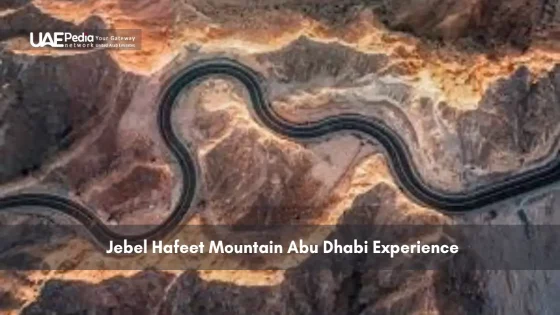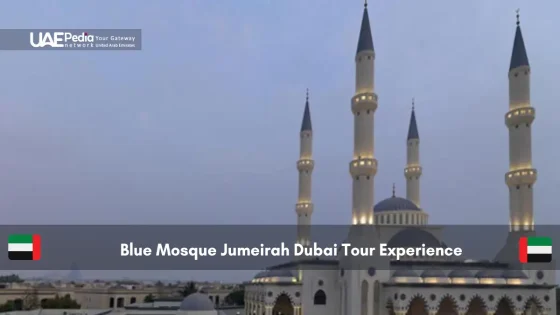What if we told you the UAE’s most iconic natural landmark isn’t a skyscraper or a desert dune? Tucked near the Omani border, this limestone giant rises 4,098 feet above sea level—a silent storyteller of ancient trade routes, Bronze Age tombs, and modern Emirati ambition.
Our journey today winds through hairpin curves to Abu Dhabi’s highest peak, where the past and present collide. You’ll trace Sheikh Zayed’s vision for preserving natural wonders while soaking in panoramas stretching from Al Ain’s lush gardens to the rugged UAE mountain ranges. This isn’t just a drive—it’s a cultural handshake between Bedouin heritage and 21st-century adventure.
Pack your curiosity (and hiking shoes) as we explore:
- Secret hot springs bubbling beneath Mubazzarah Park’s foothills
- Cycling routes that challenge even seasoned athletes
- UNESCO-recognized burial sites older than the pyramids
Whether you’re chasing sunrise views or sunset serenity, this guide serves your perfect blend of local wisdom and practical know-how. Let’s map your ascent.
Unveiling Rich Heritage and Ancient Mysteries
Step beyond the modern skyline, and you’ll find whispers of a civilization that thrived here over 5,000 years ago. Archaeologists uncovered nearly 500 stone-lined burial chambers at the base of this limestone giant—silent witnesses to the dawn of the Bronze Age in the Arabian Peninsula. “These tombs are like time capsules,” one researcher noted, “each stone telling tales of trade, rituals, and early Emirati ingenuity.”
The Hafit Period and Timeless Tombs
Dating back to 3200 BCE, the Hafit Period marks the region’s first chapter of organized society. Ancient builders stacked flat stones into beehive-shaped structures, some still standing taller than a person. Excavations since the 1950s revealed pottery fragments and tools that hint at connections stretching from Mesopotamia to the Indus Valley.
UNESCO Recognition and Historical Landmarks
In 2011, these archaeological treasures earned UNESCO World Heritage status, cementing their global importance. What makes them extraordinary? Their location—nestled where stark cliffs meet rolling sands—creates a poetic dialogue between nature and human history. Visitors today can trace finger grooves in stones placed by hands that shaped the United Arab Emirates’ earliest identity.
Local guides often share how these sites bridge generations. As one Bedouin storyteller put it: “Our ancestors’ footsteps echo here—listen closely, and you’ll hear tomorrow’s lessons.”
Exploring the Natural Landscape and Geological Wonders
Peel back the layers of time, and you’ll uncover a landscape that’s been 40 million years in the making. This natural masterpiece reveals itself through striped cliffs and twisted rock formations—each band of sediment whispering secrets from epochs when this region swam beneath ancient seas.
Fossil Discoveries and the Mountain’s Formation
Imagine holding a seashell fossil older than the Himalayas. The peak’s anticline structure—a geological fold shaped by tectonic collisions—preserves marine creatures from the Eocene era. “These limestone layers are nature’s history books,” explains a local geologist. “One cliff face might contain Miocene shark teeth, while another reveals coral reefs turned to stone.”
At Green Mubazzarah Park, steaming hot springs bubble up through cracks in the earth. These geothermal pools, heated by underground volcanic activity, offer a rare contrast to the arid surroundings. Visitors often soak here after hiking trails that wind past fossil-rich outcrops.
Climate, Flora, and Unique Desert Ecosystems
Despite scorching summers, life thrives in unexpected ways. Acacia trees claw at thin soil, while desert hyacinths bloom briefly after rare rains. The United Arab Emirates’ only native orchid clings to shaded crevices, and nocturnal species like sand foxes leave tracks across dunes.
Scientists flock here to study extremophile organisms that survive temperature swings. “This isn’t just a desert—it’s a masterclass in adaptation,” remarks a conservationist. From wind-carved canyons to hidden oases, every contour tells a story of resilience.
Thrilling Adventures and Scenic Drives
Buckle up for a white-knuckle ascent along 7.3 miles of engineering marvel. The serpentine road twisting up this limestone giant isn’t just pavement—it’s a 60-turn adrenaline symphony praised by Edmunds.com as one of Earth’s ultimate driving routes. From hairpin bends to panoramic overlooks, every meter delivers heart-pounding vistas.
The Iconic Road Experience
Professional cyclists tackle its slopes during the Jabal Hafeet Mercure Challenge, while motorists test their skills against switchbacks that drop jaws and elevate pulse rates. “It’s Monaco’s Grand Prix meets Arizona’s Sedona,” one traveler remarked. At the summit, the Mercure Grand Hotel offers a rewarding pit stop—grab Arabic coffee on their terrace as sunset paints the desert gold.
Outdoor Action Unleashed
Prefer terra firma? Lace up for trails weaving through fossil-strewn valleys or bike paths flanked by acacia trees. The higher you climb, the wider your view expands—Al Ain’s palm groves stretch like emerald lace against rust-colored dunes.
| Activity | Challenge Level | Highlights |
|---|---|---|
| Driving | Moderate | 60 turns, summit views |
| Cycling | Advanced | Annual race events |
| Hiking | Beginner-Friendly | Fossil discovery spots |
For those charting their course, this iconic landmark deserves top billing on any UAE itinerary. Whether you’re here for the drive, the climb, or the Instagram-worthy summit selfies, the journey transforms ordinary days into stories worth retelling.
Experiencing jebel hafeet mountain abu dhabi: History, Culture and Wildlife
History doesn’t just live in museums here—it breathes through desert winds and scuttles across sun-baked rocks. At the base of this iconic peak, over 500 stone tombs form a silent city older than Stonehenge. These burial sites, some large enough to walk into, reveal how Bronze Age traders connected the Arabian Peninsula to distant civilizations.
Cultural Impact and Archaeological Insights
Local guides love sharing stories about the “footprint people”—ancestors who left behind pottery stamped with designs from Mesopotamia. Recent digs uncovered carnelian beads from India, proving this area was a crossroads 3,000 years before Dubai’s spice souks existed. “Every artifact is a puzzle piece,” says an Al Ain University researcher. “We’re rewriting what we know about early Emirati society.”
Wildlife Encounters and Biodiversity Treasures
Dawn hikers might spot sand cats hunting jerboas or hear the raspy call of Arabian tahr echoing through wadis. The foothills host over 120 plant species, including the rare Moringa peregrina tree whose oil once fueled ancient lamps. Conservationists recently reintroduced striped hyenas to control rodent populations—a modern twist on age-old ecological balance.
New eco-friendly hotels near the park offer stargazing terraces where Bedouin astronomy tales come alive. It’s the perfect basecamp for travelers craving both 5-star comfort and 5,000-year-old mysteries. Ready to walk where history’s footsteps still warm the ground?
Reflections on an Enchanting Abu Dhabi Mountain Journey
Every journey leaves footprints—some on trails, others on the soul. Our exploration of this UNESCO-recognized treasure revealed ancient tombs whispering Bronze Age secrets, winding roads testing drivers’ grit, and geothermal springs defying desert logic. It’s where camel caravans once paused beneath stars now shared with stargazing travelers.
More than a physical climb, ascending this landmark becomes a dialogue across millennia. You’ll trace the same paths where traders carried Indus Valley spices and modern cyclists chase personal bests. The summit’s 360-degree views stretch from Al Ain’s date palms to the Garden City’s skyline—a living postcard of the United Arab Emirates’ past and present.
For first-time visitors, timing is key: November to March offers cool mornings perfect for hiking fossil trails. Pair your trip with Mubazzarah Park’s hot springs or Al Ain Oasis’ shaded walkways. Share your stories with fellow explorers—every sunset photo or Bedouin coffee memory adds to this place’s evolving narrative.
Whether you seek quiet reflection or pulse-quickening adventure, one truth remains: some destinations change how we see the world. This is one of them. Ready to write your chapter?
Its 5,000-year-old Bronze Age "beehive" tombs—linked to the Hafit Period—showcase early human settlement in the region. These archaeological treasures, along with fossil-rich foothills, highlight the mountain’s role in understanding trade and burial practices on the Arabian Peninsula.
Absolutely! The 11.7-km winding road—often compared to Switzerland’s Stelvio Pass—offers hairpin turns with panoramic desert-meets-city views. Time your ascent for sunset when the summit glows golden, or arrive early to beat the heat (and the supercar enthusiasts testing their engines).
Yes! Over 500 tombs dot the foothills, accessible via the Jebel Hafeet Desert Park. While you can’t enter them (preservation first!), info boards decode their structure. Pair this with a stop at Al Ain’s National Museum to see artifacts found inside, like pottery and copper tools.
The mountain’s microclimates support Arabian tahr, red foxes, and over 120 bird species. Visit the Green Mubazzarah hot springs at dawn for gazelle sightings, or hike the marked trails to spot desert hyacinths—a rare plant thriving in the rocky slopes.
Local operators like Emirates Tours offer 4x4 geology expeditions. Guides point out 25-million-year-old marine fossils embedded in limestone—proof this peak was once underwater. Don’t miss the “Cave of Lights” near the summit, where mineral veins glitter under phone flashlights!
October to March offers cooler temps (15-25°C) ideal for hiking or picnicking at Mercure Grand’s lookout. Summer visits? Stick to sunrise/sunset and air-conditioned pit stops like Al Ain Palace Museum, founded by Sheikh Zayed himself.



















